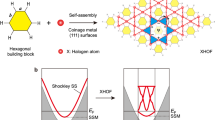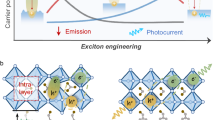Abstract
Directional bonding interactions in solid-state atomic lattices dictate the unique symmetries of atomic crystals, resulting in a diverse and complex assortment of three-dimensional structures that exhibit a wide variety of material properties. Methods to create analogous nanoparticle superlattices are beginning to be realized1,2,3,4,5, but the concept of anisotropy is still largely underdeveloped in most particle assembly schemes6. Some examples provide interesting methods to take advantage of anisotropic effects7,8,9,10,11, but most are able to make only small clusters or lattices that are limited in crystallinity and especially in lattice parameter programmability12,13,14,15,16,17. Anisotropic nanoparticles can be used to impart directional bonding interactions on the nanoscale6,18, both through face-selective functionalization of the particle with recognition elements to introduce the concept of valency19,20,21, and through anisotropic interactions resulting from particle shape13,22. In this work, we examine the concept of inherent shape-directed crystallization in the context of DNA-mediated nanoparticle assembly. Importantly, we show how the anisotropy of these particles can be used to synthesize one-, two- and three-dimensional structures that cannot be made through the assembly of spherical particles.
This is a preview of subscription content, access via your institution
Access options
Subscribe to this journal
Receive 12 print issues and online access
$259.00 per year
only $21.58 per issue
Buy this article
- Purchase on Springer Link
- Instant access to full article PDF
Prices may be subject to local taxes which are calculated during checkout



Similar content being viewed by others
References
Mirkin, C. A., Letsinger, R. L., Mucic, R. C. & Storhoff, J. J. A DNA-based method for rationally assembling nanoparticles into macroscopic materials. Nature 382, 607–609 (1996).
Park, S-J., Lazarides, A. A., Storhoff, J. J., Pesce, L. & Mirkin, C. A. The structural characterization of oligonucleotide-modified gold nanoparticle networks formed by DNA hybridization. J. Phys. Chem. B 108, 12375–12380 (2004).
Park, S. Y. et al. DNA-programmable nanoparticle crystallization. Nature 451, 553–556 (2008).
Nykypanchuk, D., Maye, M. M., van der Lelie, D. & Gang, O. DNA-guided crystallization of colloidal nanoparticles. Nature 451, 549–552 (2008).
Shevchenko, E. V., Talapin, D. V., Kotov, N. A., O’Brien, S. & Murray, C. B. Structural diversity in binary nanoparticle superlattices. Nature 439, 55–59 (2006).
Glotzer, S. C. & Solomon, M. J. Anisotropy of building blocks and their assembly into complex structures. Nature Mater. 6, 557–562 (2007).
Lapointe, C. P., Mason, T. G. & Smalyukh, I. I. Shape-controlled colloidal interactions in nematic liquid crystals. Science 326, 1083–1086 (2009).
Sacanna, S., Irvine, W. T. M., Chaikin, P. M. & Pine, D. J. Lock and key colloids. Nature 464, 575–578 (2010).
Zerrouki, D., Baudry, J., Pine, D., Chaikin, P. & Bibette, J. Chiral colloidal clusters. Nature 455, 380–382 (2008).
Srivastava, S. et al. Light-controlled self-assembly of semiconductor nanoparticles into twisted ribbons. Science 327, 1355–1359 (2010).
DeVries, G. A. et al. Divalent metal nanoparticles. Science 315, 358–361 (2007).
Liu, Q. et al. Self-alignment of plasmonic gold nanorods in reconfigurable anisotropic fluids for tunable bulk metamaterial applications. Nano Lett. 10, 1347–1353 (2010).
Ming, T. et al. Ordered gold nanostructure assemblies formed by droplet evaporation. Angew. Chem. Int. Edn 120, 9831–9836 (2008).
Tao, A., Sinsermsuksakul, P. & Yang, P. Tunable plasmonic lattices of silver nanocrystals. Nature Nanotechnol. 2, 435–440 (2007).
Alivisatos, A. P. et al. Organization of ‘nanocrystal molecules’ using DNA. Nature 382, 609–611 (1996).
Wei, Y., Bishop, Kyle J. M., Kim, J., Soh, S. & Grzybowski, B. A. Making use of bond strength and steric hindrance in nanoscale ‘Synthesis’. Angew. Chem. Int. Edn 121, 9641–9644 (2009).
Li, M., Schnablegger, H. & Mann, S. Coupled synthesis and self-assembly of nanoparticles to give structures with controlled organization. Nature 402, 393–395 (1999).
Stebe, K. J., Lewandowski, E. & Ghosh, M. Oriented assembly of metamaterials. Science 325, 159–160 (2009).
Nie, Z. et al. Self-assembly of metal-polymer analogues of amphiphilic triblock copolymers. Nature Mater. 6, 609–614 (2007).
Li, F., Yoo, W. C., Beernink, M. B. & Stein, A. Site-specific functionalization of anisotropic nanoparticles: From colloidal atoms to colloidal molecules. J. Am. Chem. Soc. 131, 18548–18555 (2009).
Millstone, J. E. et al. DNA-gold triangular nanoprism conjugates. Small 4, 2176–2180 (2008).
Zhang, Z. & Glotzer, S. C. Self-assembly of patchy particles. Nano Lett. 4, 1407–1413 (2004).
Macfarlane, R. J. et al. Establishing the design rules for DNA-mediated programmable colloidal crystallization. Angew. Chem. Int. Edn 49, 4589–4592 (2010).
Millstone, J. E. et al. Observation of a quadrupole plasmon mode for a colloidal solution of gold nanoprisms. J. Am. Chem. Soc. 127, 5312–5313 (2005).
Nikoobakht, B. & El-Sayed, M. A. Preparation and growth mechanism of gold nanorods (NRs) using seed-mediated growth method. Chem. Mater. 15, 1957–1962 (2003).
Niu, W. et al. Selective synthesis of single-crystalline rhombic dodecahedral, octahedral, and cubic gold nanocrystals. J. Am. Chem. Soc. 131, 697–703 (2008).
Jin, R., Wu, G., Li, Z., Mirkin, C. A. & Schatz, G. C. What controls the melting properties of DNA-linked gold nanoparticle assemblies? J. Am. Chem. Soc. 125, 1643–1654 (2003).
Macfarlane, R. J. et al. Assembly and organization processes in DNA-directed colloidal crystallization. Proc. Natl Acad. Sci. USA 106, 10493–10498 (2009).
Rivetti, C., Walker, C. & Bustamante, C. Polymer chain statistics and conformational analysis of DNA molecules with bends or sections of different flexibility. J. Mol. Biol. 280, 41–59 (1998).
Lu, W. et al. Super crystal structures of octahedral c-In2O3 nanocrystals. J. Am. Chem. Soc. 130, 6983–6991 (2008).
Xie, S. et al. Supercrystals from crystallization of octahedral MnO nanocrystals. J. Phys. Chem. C 113, 19107–19111 (2009).
Torquato, S. & Jiao, Y. Dense packings of the Platonic and Archimedean solids. Nature 460, 876–879 (2009).
Acknowledgements
C.A.M. acknowledges the NSF-NSEC and the AFOSR for grant support, and the DOE Office (Award No. DE-SC0000989) for support through the NU Nonequilibrium Energy Research Center. He is also grateful for an NSSEF Fellowship from the DoD. M.R.J. acknowledges Northwestern University for a Ryan Fellowship and the NSF for a Graduate Research Fellowship. R.J.M. acknowledges Northwestern University for a Ryan Fellowship. K.L.Y. acknowledges the NSF and the NDSEG for Graduate Research Fellowships. Portions of this work were carried out at the DuPont-Northwestern-Dow Collaborative Access Team (DND-CAT) beamline located at Sector 5 of the Advanced Photon Source (APS). DND-CAT is supported by E.I. DuPont de Nemours & Co., The Dow Chemical Company and the State of Illinois. Use of the APS was supported by US Department of Energy, Office of Science, Office of Basic Energy Sciences, under Contract No. DE-AC02-06CH11357. The transmission electron microscope work was carried out in the EPIC facility of NUANCE Center at Northwestern University. NUANCE Center is supported by NSF-NSEC, NSF-MRSEC, Keck Foundation, the State of Illinois and Northwestern University. Ultrathin sectioning was carried out at the Northwestern University Biological Imaging Facility supported by the NU Office for Research.
Author information
Authors and Affiliations
Contributions
M.R.J. and R.J.M. designed the systems, prepared the materials, collected and analysed the data and wrote the manuscript. B.L. analysed the data, carried out simulations of nanoparticle superlattices and wrote the manuscript. J.Z., K.L.Y. and A.J.S. collected data. C.A.M. designed the systems and wrote the manuscript.
Corresponding author
Ethics declarations
Competing interests
The authors declare no competing financial interests.
Supplementary information
Supplementary Information
Supplementary Information (PDF 2296 kb)
Rights and permissions
About this article
Cite this article
Jones, M., Macfarlane, R., Lee, B. et al. DNA-nanoparticle superlattices formed from anisotropic building blocks. Nature Mater 9, 913–917 (2010). https://doi.org/10.1038/nmat2870
Received:
Accepted:
Published:
Issue Date:
DOI: https://doi.org/10.1038/nmat2870
This article is cited by
-
Colloidal quasicrystals engineered with DNA
Nature Materials (2024)
-
Two-dimensional glass transition–like behavior of Janus particle–laden interface
Rheologica Acta (2023)
-
Role of Conformational Entropy in Complex Macromolecular Systems
Chemical Research in Chinese Universities (2023)
-
Open-channel metal particle superlattices
Nature (2022)
-
Colloidal crystal engineering with metal–organic framework nanoparticles and DNA
Nature Communications (2020)



